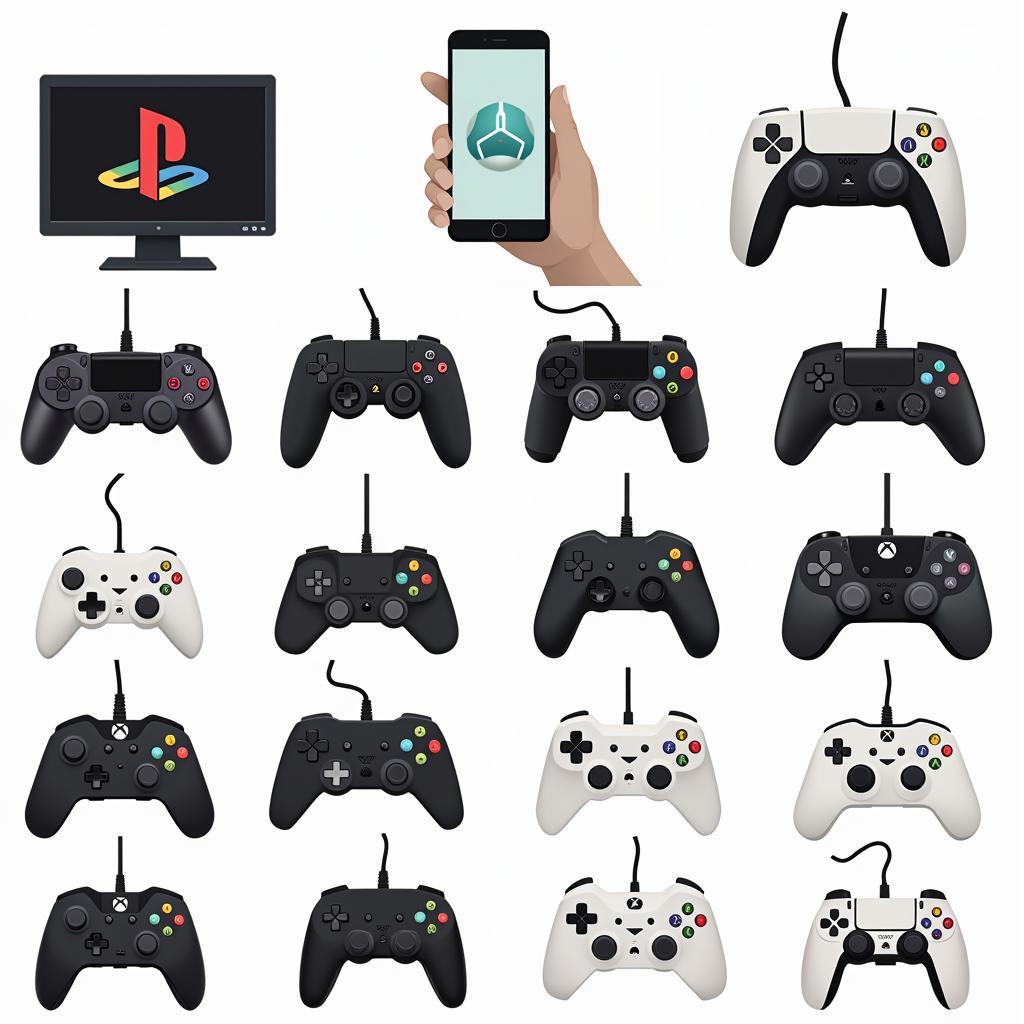Controller Button Numbers are crucial for understanding game mechanics, following tutorials, and communicating with other players. Whether you’re a seasoned gamer or just starting out, knowing what each button does can significantly enhance your gameplay experience. This guide will delve into the intricacies of controller button numbers, covering everything from basic layouts to advanced techniques.
Understanding the Standard Controller Layout
Most modern controllers, regardless of platform, follow a similar button numbering system. This standardized layout helps developers create games that are accessible to a wide audience and allows players to transition between different consoles or controllers with ease. The standard layout typically includes face buttons, shoulder buttons, triggers, directional buttons (D-pad), and analog sticks. Each button is assigned a number or letter for easy identification.
Face Buttons: The Core of Control
The face buttons are often the most frequently used buttons on a controller. They are typically numbered 1 through 4, or sometimes represented by letters like X, Y, A, and B. These buttons are used for a variety of actions, such as jumping, attacking, interacting with objects, and navigating menus. The specific function of each button can vary depending on the game.
Shoulder Buttons and Triggers: Adding Depth to Gameplay
Shoulder buttons and triggers provide additional input options beyond the face buttons. They are usually located on the top edge of the controller and are often used for aiming, firing weapons, accelerating, braking, or modifying actions performed with the face buttons. The triggers, in particular, offer analog input, allowing for varying degrees of pressure sensitivity.
Directional Buttons (D-pad): Precise Navigation
The D-pad, a four-way directional control, allows for precise movement or selection. It is commonly used for navigating menus, selecting items, or controlling character movement in 2D games. In some games, the D-pad can also be used for secondary functions, such as switching weapons or changing camera angles.
Analog Sticks: Fluid Movement and Camera Control
Analog sticks provide fluid and precise control over movement and camera angles in 3D games. The left analog stick is typically used for character movement, while the right analog stick controls the camera. Some games also utilize the analog sticks for other functions, such as aiming or steering vehicles.
Controller Button Numbers Across Different Platforms
While the general layout remains consistent, the specific numbering or labeling of controller buttons can differ slightly between platforms. For instance, the Xbox controller uses letters (A, B, X, Y), while the PlayStation controller uses shapes (X, O, Square, Triangle). Understanding these differences is crucial for following platform-specific guides and tutorials.
Xbox Controller Button Numbers
The Xbox controller uses A, B, X, and Y for the face buttons, LB and RB for the shoulder buttons, LT and RT for the triggers, and a standard D-pad. The left and right analog sticks are designated as LS and RS, respectively.
PlayStation Controller Button Numbers
The PlayStation controller utilizes X, O, Square, and Triangle for the face buttons, L1 and R1 for the shoulder buttons, L2 and R2 for the triggers, and a D-pad. The left and right analog sticks are labeled L3 and R3.
Nintendo Switch Controller Button Numbers
The Nintendo Switch Joy-Cons have a slightly different layout. They utilize A, B, X, and Y for the face buttons, L and R for the shoulder buttons, ZL and ZR for the triggers, and a D-pad. The left and right analog sticks function similarly to other controllers.
Why Knowing Controller Button Numbers is Important
Understanding controller button numbers is fundamental for several reasons:
- Following Tutorials and Guides: Many online resources and in-game tutorials refer to specific button numbers. Knowing these numbers allows you to follow instructions accurately and effectively.
- Communicating with Other Players: Clear communication is essential in multiplayer games. Using accurate button terminology helps avoid confusion and facilitates coordinated gameplay.
- Mastering Game Mechanics: Understanding the function of each button is crucial for executing complex maneuvers and mastering game mechanics.
Conclusion
Mastering controller button numbers is essential for any gamer looking to improve their skills and enjoy a richer gaming experience. By understanding the standard layout and the platform-specific differences, you’ll be well-equipped to conquer any game. Remember, practice makes perfect! Knowing your controller is the first step towards becoming a true gaming master.
 Different Controller Types for Various Gaming Platforms
Different Controller Types for Various Gaming Platforms
FAQ
-
What does the L1 button do on a PlayStation controller?
- The L1 button is a shoulder button typically used for aiming, modifying actions, or accessing secondary functions.
-
What is the difference between a trigger and a shoulder button?
- Triggers are analog input buttons that offer pressure sensitivity, while shoulder buttons are digital input buttons.
-
What does the D-pad stand for?
- D-pad stands for Directional Pad.
-
How can I customize controller button mappings?
- Many games and operating systems allow you to customize controller button mappings in the settings menu.
-
Why are controller button numbers important for online gaming?
- Controller button numbers are important for clear communication with other players, especially in cooperative or competitive scenarios.
-
Are there any universal controller button standards?
- While most controllers follow a similar layout, there are minor differences in labeling between platforms.
-
What are the benefits of using a controller over a keyboard and mouse?
- Controllers are often preferred for certain genres, like racing and fighting games, due to their ergonomic design and analog stick controls.
Need Help? Contact Us!
For any questions or assistance, feel free to reach out to our 24/7 customer support team:
Phone: 0902476650
Email: [email protected]
Address: 139 Đ. Võ Văn Kiệt, Hoà Long, Bà Rịa, Bà Rịa – Vũng Tàu, Việt Nam.
We’re here to help you with all your gaming needs!





